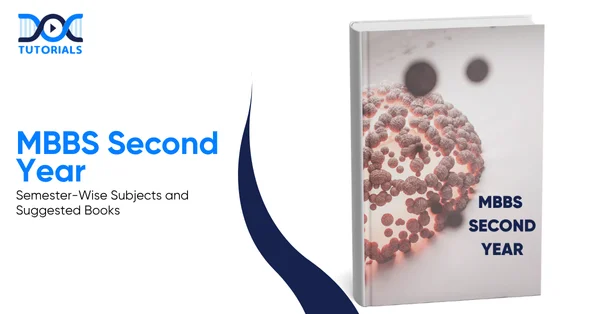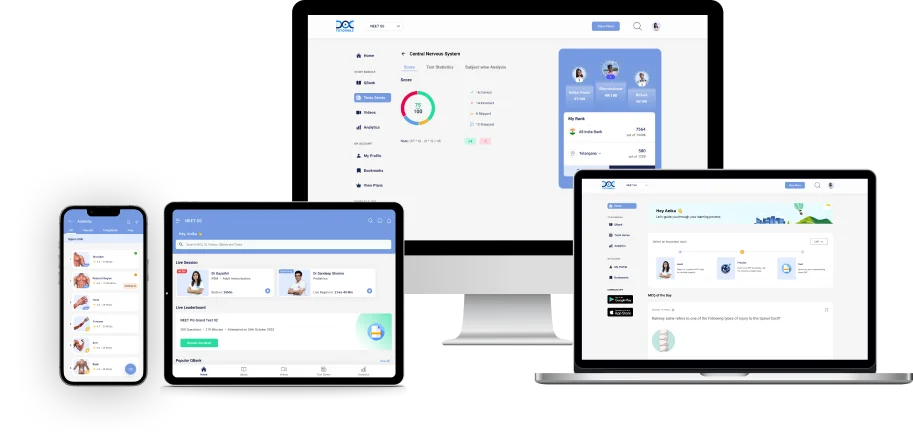MBBS Second Year: Semester-Wise Subjects and Suggested Books

For a medical exam like MBBS, every step must be taken appropriately to stand out with enhanced knowledge and clinical skills. Hence, clearing the MBBS 2nd year syllabus is of prime importance. In the 2nd year, MBBS has a total of 3 subjects: Pathology, Pharmacology, and Microbiology.
This guide provides a detailed overview of each of these subjects, their set of recommended books, and helps MBBS 2nd year students prepare for competitive exams. Continue reading to gain a detailed understanding of the various subjects covered in the second-year MBBS and their recommended resources.
Subjects in MBBS Second Year: Detailed Guide
The following section provides a detailed overview of the MBBS second year subjects, which lists the essential topics under each subject as well:
- Pathology: Study of Disease in Cells and Tissues
Although anatomy and physiology provide a glimpse of cell structure and function, pathology offers a detailed understanding of cell functioning, its structure, and the abnormal conditions related to it.
Go through the topics mentioned below to have a more profound knowledge of diseases and their etiopathogenesis on a cellular level:
- General Pathology: This branch of pathology focuses on cell injury, inflammation, cell disturbances, and related aspects.
- Systemic Pathology: Systemic pathology refers to the pathological changes that affect every individual organ system and their impact on the body as a whole.
- Pharmacology: Drug Interaction in Living Beings
Pharmacology is the study of drugs in the human body, examining how the body affects them and how they, in turn, affect the body, making it a comprehensive subject essential for physicians in every area of practice.
The following section lists some of the crucial topics under pharmacology:
- General Pharmacology: General pharmacology teaches students about the distribution, metabolism, and elimination of drugs, as well as the adverse reactions they may cause.
- Autacoids: The pharmacology of autacoids explores their mechanism of action in the blood and how they are produced on demand, thereby ensuring the smooth functioning of the body.
- Autonomic Nervous System: ANS pharmacology focuses on muscle relaxants, neurohumoral transmission, the parasympathetic nervous system, and related drug interactions.
- Central Nervous System: This part of pharmacology involves the common neurotransmitters, their functions, how the drugs affect them, and how to increase their efficiency.
- Microbiology: Study of Microscopic Organisms
Microbiology refers to the study of microbes, including bacteria, viruses, and other microorganisms, that affect human life. The structure and functions of microbes are crucial for a physician to understand the cause of a disease and the appropriate treatment for it.
Although microbiology is an extensive subject, here are a few topics that cover the vital segment of the subject:
- Bacteriology: The branch of microbiology that focuses on the structure and morphology of bacteria.
- Virology: Virology is the study of viruses, including their structure and function.
- Bacterial and Viral Genetics: This branch of microbiology focuses on the process of how bacteria and viruses pass their genetic information to their next generation.
- Sterilisation and Disinfection: In this, students are taught about the methods to destroy and eliminate microorganisms completely.
- Microbes Associated with Gastrointestinal Infections: This branch deals with the sterilisation and disinfection of the necessary articles used in the sterile procedures and the science behind it.
- Collection and Transport of Samples: This part teaches students to collect and transport samples properly, ensuring negligible scope for contamination that may result in discrepancies in the reports.
- Common Laboratory Methods for Diagnosing Fungal Infections: Fungal infections also constitute a vast segment of microbiology, causing significant, life-threatening diseases. Learning about them will help to have a better clinical understanding of the diseases.
- Inpatient Clinical Postings: Understanding Patient Care in the Hospital
Inpatient clinical postings are introduced to second-year MBBS students to give them a glimpse of the clinical duties that begin during the internship period. These brief postings also help them become acquainted with real-life patients and hospital scenarios, thereby enhancing their clinical practice for the future.
- Outpatient Department Postings (OPD): Understanding Patient Care in Clinics
Second-year students are posted in various departmental OPDs to experience real-life cases and correlate them with theoretical concepts. The OPDs are clinic settings within hospitals, operating at scheduled hours every day for patients who do not require hospitalisation.
What Books are Recommended for the MBBS Second Year?
Go through the following table to get an overview of all the required books that are recommended for the subjects in the MBBS second year to have a better learning experience:
| Subject | Name of the Book | Author |
| Pathology | Pathological Basis of Diseases | Robbin’s |
| Textbook of Pathology | Harsh Mohan | |
| Microbiology | Medical Microbiology | Greenwood Slack |
| Jawetz, Melnick, and Adelberg’s Medical Microbiology | Geo F. Blocks, Stephen A. Morse | |
| Parasitology (Protozoology and Helminthology) | K.D. Chatterjee | |
| Pharmacology | Basic and Clinical Pharmacology | Bertram G. Katzung |
| Fundamentals of Experimental Pharmacology | MN Ghosh | |
| The Pharmacological Basis of Therapeutics | Goodman and Gilman’s |
How to Study for the MBBS Second Year?
Just as you have grasped the base subjects in the 1st year of MBBS, it is now essential to have a strategic study plan to ace the second year with optimum practical knowledge. The following tips will help you to study and retain the subjects better:
- Consistent Study
Avoid last-minute study hassles and start preparation from the beginning of the course itself. It will help students study effectively, avoiding marathon study sessions before exams, and studying for one to two hours daily with strategic planning results in appropriate preparation for the exams.
- Take Help from Online Platforms
With significant technological advancements, students now have access to numerous online resources that help them clarify their doubts and solidify their concepts. Before starting their clinical subjects in 3rd year, clearing the clinical and para-clinical subjects in the second year of the MBBS is important for proper clinical practice.
- Correlate the Subjects
The subjects in the 2nd year are interrelated with each other. Hence, if the subjects are interlinked while studying, it will help students learn better and have a more compact study session. For example, while studying a disease in Pathology, the management of that disease can be studied from Pharmacology.
- Correlate During IPD and OPD Postings
During the clinical postings, subjects should be correlated with the clinical scenario to enhance retention and understanding of the case. Compare the theoretical knowledge with the practical cases and observe them.
- Use Mnemonics
Subjects like pharmacology are vast and volatile. Therefore, creating mnemonics and using them to memorise the subject will help you remember the minor details.
- Emphasise High-Yield Topics
Review the PYQs to identify high-yield and frequently repeated topics. The students can also seek help from their seniors to gain valuable insights into the areas that need to be prioritised.
FAQs about MBBS Second Year Subjects
- How many subjects are there in the 2nd Year MBBS?
The second year of the MBBS program comprises 3 main subjects: Pathology, Pharmacology, and Microbiology.
- Which subject is easiest in the second year of MBBS?
Although different students have varying perceptions, the majority consider Pathology to be the easiest subject in the second year of the MBBS program.
- How many hours to study in the 2nd year of MBBS?
Including lectures and classes, a student must spend 6 to 8 hours studying in the second year of the MBBS program. This helps to avoid last-minute cramming before the exams.
- What are clinical postings in the 2nd year?
Clinical postings, also referred to as hospital postings, provide medical students with hands-on experience in handling real-life cases.
- What are the passing marks for the MBBS 2nd year?
In India, a student must achieve a minimum of 60% in practical and 40% in theory for each subject, with a total of 50% in aggregate in the university exams.
- Which subject is complex in the 2nd year of MBBS?
The students consider Pharmacology the most challenging subject in the second year of MBBS, owing to its fact-heavy content and vast syllabus.
Conclusion
While the first-year subjects lay the foundation for future doctors, the second-year subjects strengthen their pre- and para-clinical knowledge, preparing them for a smooth transition into the clinical subjects. Opting for appropriate study habits, along with proper resources, helps students score better and grasp concepts more effectively.
If you are looking for a reliable medical study platform, DocTutorials has got you covered. Our in-depth MBBS curriculum offers 3D animated lectures, PYQs, Qbanks, live doubt-clearing, and interactive sessions with experts well-versed in the medical field.
Join DocTutorials today to ace your medical exam with our detailed MBBS course!
Latest Blogs
-

INI CET Exam Pattern 2025: A Complete Guide with Subject-Wise Weightage
The Institute of National Importance Combined Entrance Test (INI CET) is your key to entering some of the most prestigious…
-

NEET PG Registration 2025: An Essential Guide For Exam Prep
The NEET PG registration, which is conducted online, is a crucial step in the exam process. Filling out the NEET…
-

NEET PG Syllabus 2026: A Must-Have Complete Guide for Exam Success
The NEET PG Syllabus acts as one of the foundation stones for aspiring postgraduate medical students like you who are…




